Josiah Stone and others first established this engineering company in 1842 and there's more information on the history and activities of the firm here, in the indispensible Grace's Guide. The company became involved in the supply of electric lighting systems, dynamos and batteries for railway carriages world-wide as well as steam-powered generators. The railway product range further diversified before the company was taken over by Platt Brothers in 1958, trading as Stone-Platt Industries until closure in 1982.
Locomotive applications in Britain
British railway companies did not exactly fall over themselves to embrace locomotive steam turbo-generators but Thompson's B1s were fitted, together with some of the L.N.E.R. 'Pacifics'. Bullied's 'Pacifics' for the S.R. were similarly equipped, as were, I understand, the last two L.M.S. 'Coronation' class. In general, the installations provided electric headcode lamps at both ends in the normal positions, tail lamps (for running light engine) together with a gauge lamp and an overhead cab light (only used when the locomotive was stationary, to preserve the driver's 'night vision'). Sometimes, a lamp was provided under the cab to allow the fireman to check the overflow from the injectors to ensure he was not 'wasting water'.
The pictures below show the arrangements on'B1' 'Mayflower'.

There are four white electric headlamps, plus one red tail lamp. Conventional lamp irons are also fitted to allow oil lamps to be carried where required.
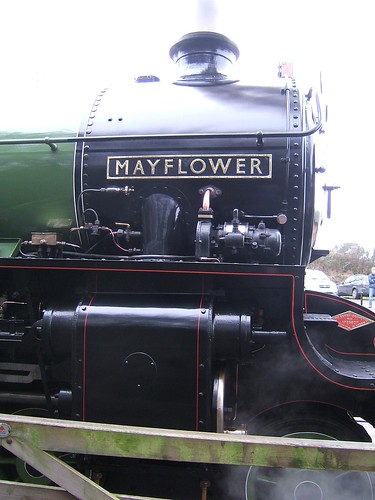
Mayflower's Stone's Steam Turbo Generator is neatly mounted adjacent to the smokebox, discharging its exhaust into the smokebox. All the electric wiring is run in steel conduit.

Detail of the white and red lamps in the middle of the buffer beam.
Locomotive applications Overseas
Railways overseas, with their interest in providing more powerful headlamps, were far more enthusiastic in adopting steam electric generators and there are pictures taken in various countries below.
United States of America
This Baldwin 2-8-0 (awaiting restoration), built in 1907, which I found during my visit to the State Railroad Museum, Boulder City in 2008, represents typical American practice. There's a little more about this exhibit here.
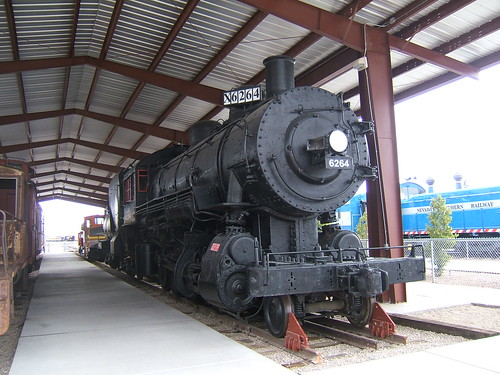
6264: The generator is on top of the firebox, the headlamp incorporates diagonal 'sidelights' displaying the locomotive number and wiring is carried in fixed or flexible conduit.
During WWII, America supplied locomotives to a number of countries and many of these had steam electric generators
Zambia
The following pictures show British-built locomotives for Africa now preserved as static exhibits in Livingstone Railway Museum, Zambia, as described here
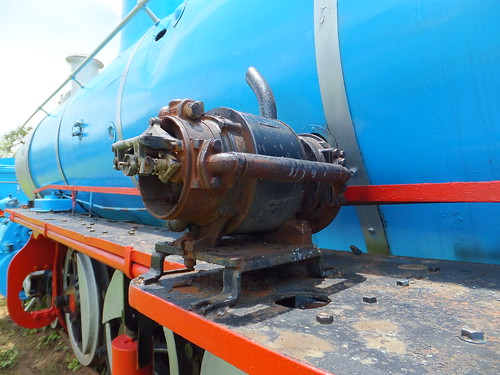
Locomotive running number 1126, showing part-dismantled steam turbine electric generator on fireman's side foot-framing (Sharp Stewart 4862 of 1902).
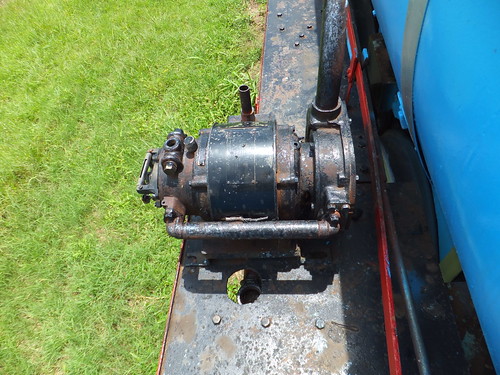
Another view of the steam turbine electric generator on No. 1126, showing rating plate 'Stone's Turbo Generator (Patented) No. 2461, 500 Watts, J. Stone & Co. Ltd, Deptford, London' (the company became limited in 1904).

Locomotive running number 70, built Neilson Reid, showing the electric headlamp and, mounted immediately behind, the steam turbine electric generator.
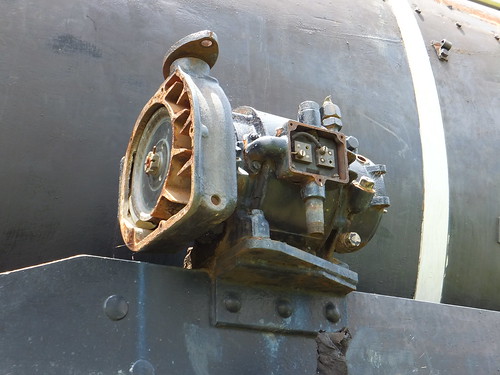
20th class No. 708 built by Beyer Peacock, works no. 7693 of 1954, showing part-dismantled steam turbine electric generator.
I also saw this type of equipment still in use when I enjoyed a footplate trip on the steam-hauled dining train, the 'Royal Livingstone Express', operated by the Victoria Falls Steam Railway, as described here.

The driver adjusts the cock supplying steam to the generator on the right, a J. Stone & Company Ltd product. The thin copper pipe is the steam supply, the vertical tube is the exhaust and the horizontal conduit is the electrical output (which changes into a pair of dangling wires leading to the cab!).
Ukraine, Mongolia & Russia
Russian-designed steam locomotives use electricity to work head lights and tail lights, illuminate the cab and the important water gauges. Electricity also powers the radio equipment used for train control. My visit to Ukraine in 2005 to drive preserved steam on the main line is described starting here. In 2012, my visit to Mongolia and Russia (described here) found a number of similarly-equipped Russian-designed locomotives in museums or 'plinthed' at stations.

Em 735-72 appears to have two genenerators on the top of the firebox, one either side of the chime whistle.

Even this 0-4-0 tank B2137 has a generator on the top of the firebox, with its steam exhaust pipe pointed upwards.

Su 251-86 showing the steam generator atop the firebox.

Attempted repairs to the turbo-generator on preserved Su 251-86 at Chernivtsi Motive Power Depot.
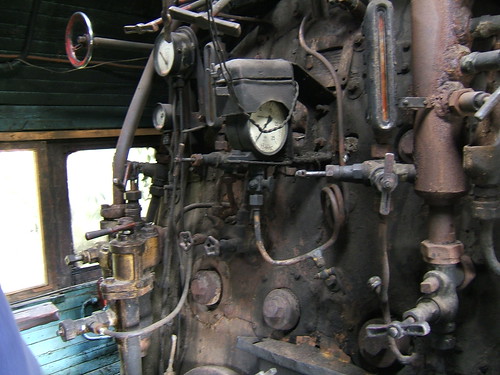
Class 'L' 2-10-0 freight locomotive L3535 at Chernivtsi Motive Power Depot showing the electric illumination of the dual boiler pressure gauge.
Poland
On my trip to Poland in 2003 (described here) I discovered that Polish steam locomotives usually showed three electric head lamps, as shown below.

Pt47-65 at Zybasyn, showing the three electric head lamps customarily carried.

Top view of Pt47-65. Note the air horn on cab roof and exhaust from steam turbine generator, which can be seen on the foot-framing, just ahead of the cab.
Other countries
I've found similar arrangements in a number of other countries, but they are not detailed here.
Beyond Illumination
Electricity, of course, has other potential applications on a steam locomotive beyond electric lighting. The use to power radio equipment in some countries has already been mentioned.
In the UK, The Automatic Train Control (ATC) introduced by the Great Western, followed by the Hudd system developed for use on the London, Tilbury and Southend Section of the L.M.S. were battery powered. The Hudd system was, after further work, adopted as the British Railways Automatic Warning System (AWS) with its distinctive heavy-duty battery box and came into widespread use before the demise of steam in the UK.
Electric speedometers on steam locomotives, where a generator rotated by a coupled wheel feeds a suitably-calibrated voltmeter, were also common on express locomotive classes.
Today, preserved steam locomotives running on the main line must not only be provided with 'Classic' AWS, but must have full Train Protection & Warning System (TPWS) capability, combining AWS with overspeed and train stop features, together with an On Train Monitoring Recorder (OTMR) - the railway equivalent of an aircraft's 'Black Box'.
Related picture albums
'Mayflower'.
Nevada State Railroad Museum, Boulder City.
Livingstone Railway Museum, Zambia.
Victoria Falls Steam Railway, Livingstone, Zambia.
Ukraine Steam.
Polish Railways (PKP).
